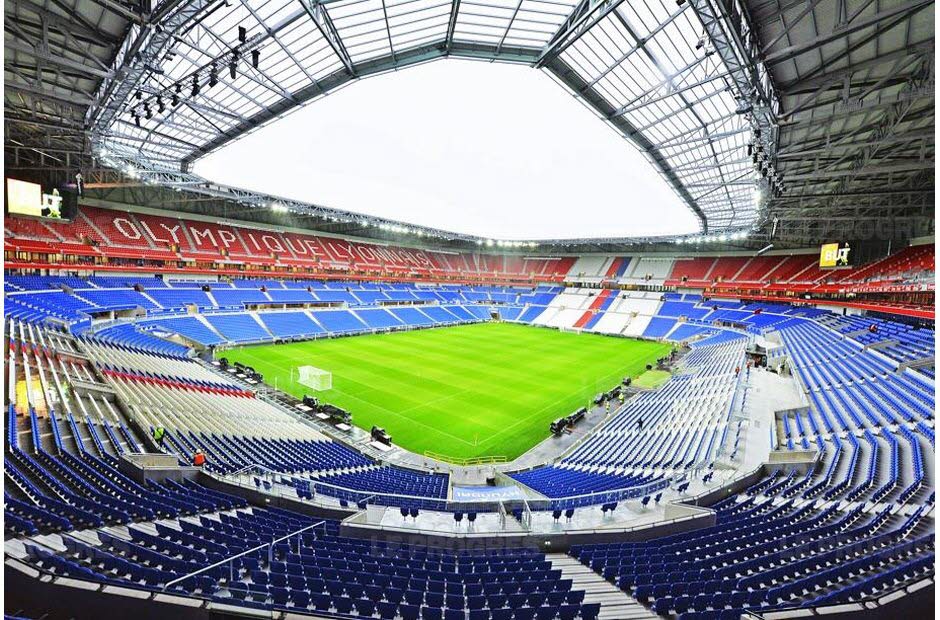The European football championship, known as Euro 2016, commences today in host nation France. The tournament will be played at ten stadiums across the country and will showcase some $1.8 billion dollars in stadium construction and upgrades.
The 15th iteration of the continental championship will be contested from June 10 through July 10 and will feature an expanded field of 24 teams for the first time in its history. Spain is the two-time defending champion.
The tournament games will be played in some brilliant new stadiums, a slew of refurbished pitches, and some classic venues with rich histories.
The newest stadium for this year’s tournament, and the most highly anticipated, is the Parc Olympique Lyonnais (shown above). Opened only in January of this year, the project was completed at a cost of almost $460 million. It is the only stadium in France privately owned by the local club, Olympique Lyonnais. The club plans to use the model of Arsenal and the Emirates, generating funds through stadium adjacent development and the higher match-day revenue afforded by ownership. Designed by Populous, the 60,000-seater has opened to rave reviews, and will be the host of the 2019 FIFA Women’s World Cup final match.
Another highly anticipated new stadium is the Stade de Bordeaux. The 42,000 capacity stadium opened in 2015. Distinctive in appearance due to its 900 exterior stanchions designed to resemble a local forest, it was designed by Swiss architects Herzog and de Mauron. The firm is known for their design of the Tate Modern in London, as well as the Allianz Arena in Munich and the famous “bird’s nest” Beijing National Stadium of the 2008 Olympic games. It worried fans with its rhythmic movement generated by fan exuberance upon opening, but stadium officials suggested the movement was normal due to its metallic structure.
Also on view this summer will be some recently designed stadiums sporting the best in stadium design. The Stade Pierre Mauroy in Lille is the first major French stadium with a retractable roof. Opened in 2012, half of the pitch can be raised a few meters, and the other half slides under it, providing ultimate flexibility (you can see a video here). The Stade de Nice, opened in 2013, is fitted with a number of eco-friendly design elements.
Other stadiums have had major refurbishments leading up to this year’s European championships, with an eye toward the Women’s World Cup in 2019. The Stade Bollaert-Delelis in Lens underwent a $79-million renovation. Stade Velodrome in Marseille was fitted with a new roof to cover the 1990s expansion of additional seating, at a cost of over $300 million.
The tournament will also feature a number of smaller historical stadiums, including Stadium de Toulouse, built in 1937, and Saint-Etienne’s Stade Geoffroy Guichard, built in 1931. The oldest stadium in the tournament, technically, is the Parc de Princes in Paris. Home to super club PSG, the stadium was originally built in 1897, though it was rebuilt in 1937, again in 1972, and the owners of PSG funded another $85-million facelift prior to this year’s tournament.
This year’s final will be played at the 80,000-seat Stade de France just outside of Paris. The fifth-largest stadium in Europe, it was opened for the 1998 World Cup, and was the site of France’s World Cup final victory over Brazil that year (and also Zinedine Zidane’s infamous headbutt and red card). It also hosted Champions League finals in 2000 and 2006. Heightened security is expected at the stadium, and across all venues tournament wide, as the stadium was one of the targets of the November 2015 terrorist attacks in Paris.
As always, the Euros promise an abundance of great soccer on the pitch, and as a bonus this year, it will give the world’s fan a glimpse into the best in soccer stadium design.

